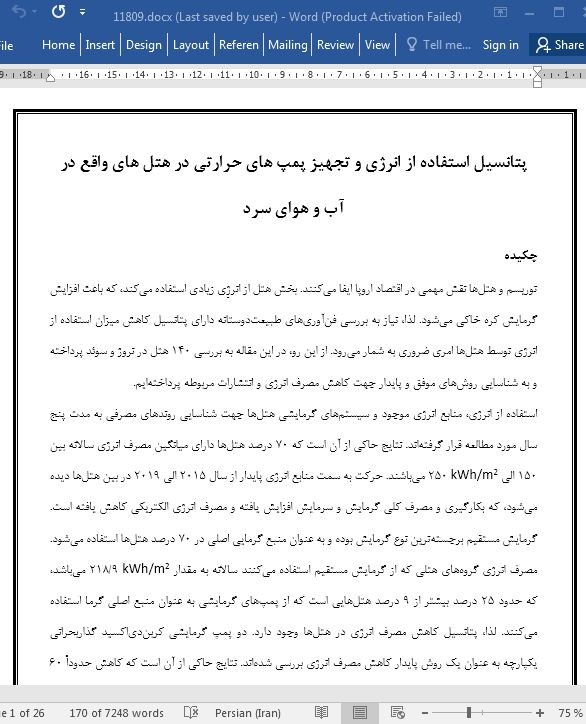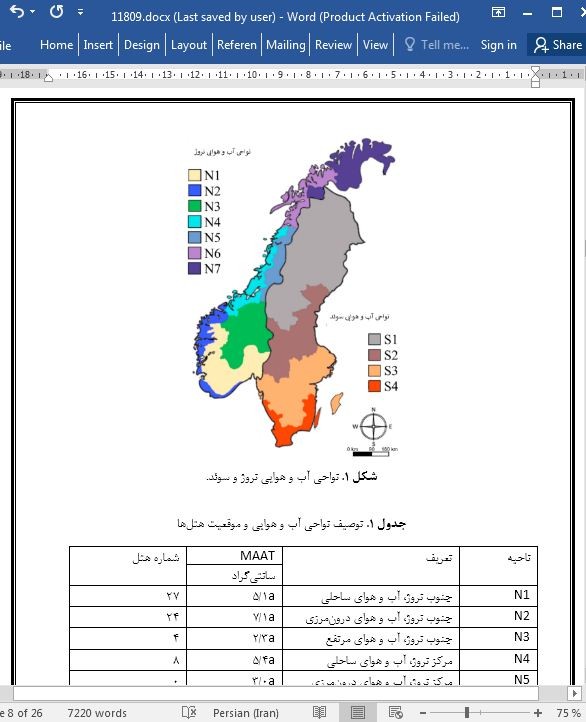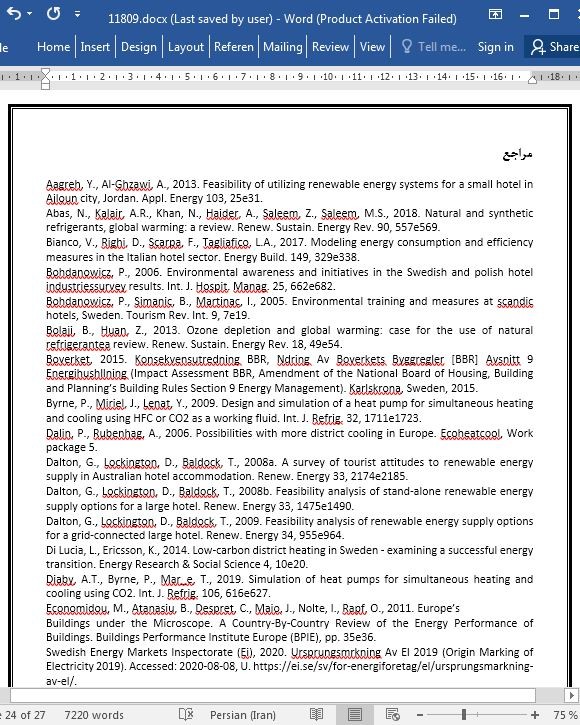
پتانسیل استفاده از انرژی و تجهیز پمپ های حرارتی در هتل های واقع در آب و هوای سرد
چکیده
توریسم و هتل ها نقش مهمی در اقتصاد اروپا ایفا می کنند. بخش هتل از انرژِی زیادی استفاده می کند، که باعث افزایش گرمایش کره خاکی می شود. لذا، نیاز به بررسی فن آوری های طبیعت دوستانه دارای پتانسیل کاهش میزان استفاده از انرژی توسط هتل ها امری ضروری به شمار می رود. از این رو، در این مقاله به بررسی 140 هتل در نروژ و سوئد پرداخته و به شناسایی روش های موفق و پایدار جهت کاهش مصرف انرژی و انتشارات مربوطه پرداخته ایم.
استفاده از انرژی، منابع انرژی موجود و سیستم های گرمایشی هتل ها جهت شناسایی روندهای مصرفی به مدت پنج سال مورد مطالعه قرار گرفته اند. نتایج حاکی از آن است که 70 درصد هتل ها دارای میانگین مصرف انرژی سالانه بین 150 الی kWh/m2 250 می باشند. حرکت به سمت منابع انرژی پایدار از سال 2015 الی 2019 در بین هتل ها دیده می شود، که بکارگیری و مصرف کلی گرمایش و سرمایش افزایش یافته و مصرف انرژی الکتریکی کاهش یافته است. گرمایش مستقیم برجسته ترین نوع گرمایش بوده و به عنوان منبع گرمایی اصلی در 70 درصد هتل ها استفاده می شود. مصرف انرژی گروه های هتلی که از گرمایش مستقیم استفاده می کنند سالانه به مقدار kWh/m2 9/218 می باشد، که حدود 25 درصد بیشتر از 9 درصد هتل هایی است که از پمپ های گرمایشی به عنوان منبع اصلی گرما استفاده می کنند. لذا، پتانسیل کاهش مصرف انرژی در هتل ها وجود دارد. دو پمپ گرمایشی کربن دی اکسید گذاربحرانی یکپارچه به عنوان یک روش پایدار کاهش مصرف انرژی بررسی شده اند. نتایج حاکی از آن است که کاهش حدوداً 60 درصدی مصرف انرژی گرمایی امکان پذیر است.
1. مقدمه
بر اساس طرح استراتژیک EU برای سرمایش وگرمایش ساختمان ها، روش های جدید و پایداری می بایست برای کسب اهداف درجه 2 توافقنامه پاریس در خصوص تولید انرژی گرمایی ایجاد گردد (2016، EC). در حال حاضر، ساختمان ها بیش از4 درصد مصرف انرژی را در اروپا به خود اختصاص داده اند (روزلات، 2018). حدود3/1این انرژی و انتشارات مربوطه به بخش تجاری اختصاص دارد (یورواستات، 2017). با اعمال معیارهای افزایش کاربری و مطالبات مدیریتی، تخمین زده می شود که حدود 30 درصد صرفه جویی در بخش تجاری امکان پذیر است (اکونومیدوو همکاران، 2011؛ EC، 2006).
4. نتیجه گیری
مصرف انرژی در هتل های سردسیر با استفاده از اندازه گیری های میدانی از سال 2015 الی 2019 مورد بررسی قرار گرفته است. بر اساس تحقیقات انجام شده بر روی 140 هتل در کشور نروژ و سوئد، نتایج زیر بدست آمده اند.
• 70 درصد از هتل ها دارای میانگین مصرف انرژی سالانه بین سالkWh/m2/ 150 الی 250، بوده و میانگین آنها سالkWh/m2/ 213 می باشد. لذا پتانسیل کاهش فراتر مصرف انرژی نیز وجود دارد.
• تغییر به سمت منابع پایدار انرژی از سال 2015 الی 2019 در بین هتل های نمونه دیده می شود. برق پراستفاده ترین منبع انرژی در هتل ها بوده و بیش از70 درصد کل مصرف انرژی را در سال 2015 به خود اختصاص می دهد. هرچند کل مصرف برق از سال 2015 الی 2019 کاهشی 8 درصدی به نفع گرمایش بخشی داشته است، که در همین دوره افزایشی 7 درصدی داشته است. دسترسی به گرمایش بخشی و سرمایش از سال 2015 الی 2019 0/18 افزایش و %9/10 افزایش داشته است. تعداد هتل هایی که تنها به برق دسترسی دارند در طول این دوره 5 ساله نصف شده است.
Abstract
Tourism, and thereby hotels, play a crucial role in the European economy. The hotel sector features high energy consumption, which greatly contributes to the global warming effect. Thus, there is a need to investigate environmentally friendly technologies that have the potential to reduce energy usage within this sector. Information regarding the current status of the energy consumption in hotels is essential. Therefore, a study of 140 hotels in Norway and Sweden is presented in this paper to identify successful and sustainable measures to reduce energy consumption and related emissions.
The energy use, available energy sources and thermal systems in the hotels are studied over a five-year period to identify consumption trends. The results reveal that 70% of the hotels have a mean annual energy consumption between 150 and 250 kWh/m2. A shift towards sustainable energy sources is observed in the hotels from 2015 to 2019, where application and overall consumption of district heating and cooling have increased, while electrical energy consumption has been reduced. District heating is the most prominent source of heating and is applied as the primary heat source in 70% of the hotels. The specific energy consumption for the group hotels that apply district heating is 218.9 kWh/m2/year, which is nearly 25% higher than the specific energy consumption of the 9% of hotels that apply heat pump solutions as a primary heat source. Thus, there is a potential to reduce the specific energy consumption in hotels. Two integrated transcritical carbon dioxide (CO2) heat pumps were investigated as a sustainable measure to reduce energy consumption. The results reveal that a reduction of thermal energy consumption of approximately 60% can be achieved.
1. Introduction
According to the EU strategic plan for heating and cooling in buildings, new and sustainable solutions for generating thermal energy must be applied to achieve the 2-degree goal of the Paris Agreement (EC, 2016). Presently, buildings account for more than 40% of the total end-use energy consumption in Europe (Rousselot, 2018). Approximately 1/3 of this energy consumption and related emissions is connected to the commercial sector (Eurostat, 2017). By implementing measures to increase efficiency and manage demands, it is estimated that energy saving of 30% can be achieved within the commercial sector (Economidou et al., 2011; EC, 2006).
4. Conclusions
The energy consumption in cold-climate hotels has been studied for the period 2015e2019 by using field measurements. The following conclusions can be made based on the investigation of 140 hotels in Norway and Sweden.
70% of the hotels have a mean annual energy consumption between 150 and 250 kWh/m2 /year, with the mean value for all hotels being 213 kWh/m2 /year. Thus, there is a potential to further reduce the energy consumption in the hotels.
A shift towards sustainable energy sources is observed in the sample hotels from 2015 to 2019. Electricity is the most applied energy source in hotels and accounted for more than 70% of the total energy use in 2015. However, the overall electricity consumption was reduced by 8% from 2015 to 2019 in favor of district heating, which increased by 7% over the same period. The access to district heating and cooling increased by 18.0 and 10.9% from 2015 to 2019. The number of hotels with only electricity access has been halved over the five-year period.
چکیده
1.مقدمه
نامگذاری
2. روش ها و مواد
2.1. جمع آوری دادهها
2.2. طبقه بندی هتل ها
3. نتایج و بحث
3.1. تحلیل انرژی
3.2. پمپ های گرمایشی هتل ها
4. نتیجه گیری
مراجع
Abstract
Nomenclature
1. Introduction
2. Methods and materials
2.1. Data collection
2.2. Hotel classification
3. Results and discussion
3.1. Energy analysis
3.2. CO2 heat pump solutions for hotels
4. Conclusions
References
- اصل مقاله انگلیسی با فرمت ورد (word) با قابلیت ویرایش
- ترجمه فارسی مقاله با فرمت ورد (word) با قابلیت ویرایش، بدون آرم سایت ای ترجمه
- ترجمه فارسی مقاله با فرمت pdf، بدون آرم سایت ای ترجمه



